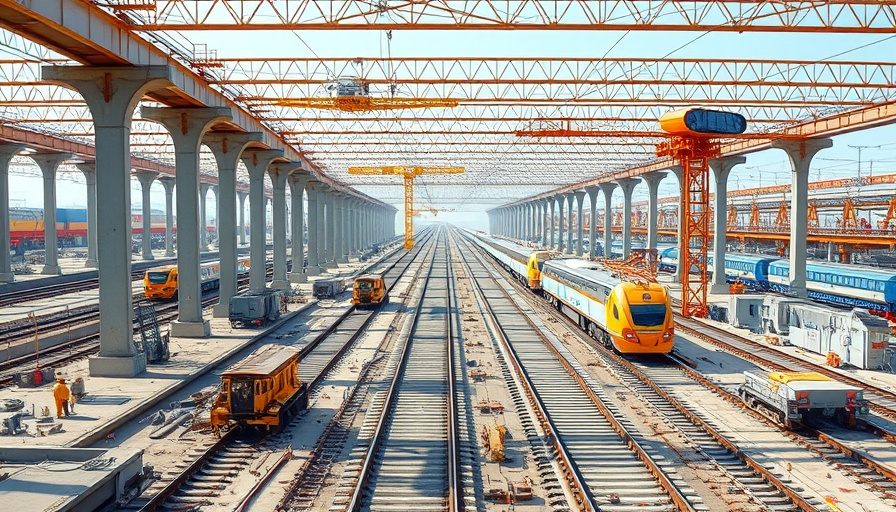
Will USDOT’s Review Halt California’s Ambitious Rail Project?
In a move that could significantly reshape infrastructure development in California, U.S. Transportation Secretary Sean Duffy has initiated a review of the California High-Speed Rail Authority (CHSRA). This investigation could potentially lead to the clawback of $4 billion in federal grants allocated for the high-speed rail line intended to connect Los Angeles and San Francisco. Amid rising costs and persistent delays, this scrutiny raises questions about the feasibility and future of the ambitious project.
The Promise and Peril of High-Speed Rail
California’s high-speed rail project was once touted as a transformative infrastructure initiative. Voters approved a $9.95 billion bond in 2008, envisioning a seamless rail connection across the state. However, initial projections estimating the total cost at $33 billion were quickly overshadowed by a reality where the anticipated budget ballooned beyond $35 billion for just a section between Merced and Bakersfield. Critics have pointed to these rising expenses and the significant funding gap – projected at $6.5 billion – as indicators of mismanagement and a possible failure to deliver on promises made to taxpayers.
Reviewing the Past: A Cycle of Funding and Setbacks
The USDOT’s current review echoes a series of challenges faced by the CHSRA. During the Trump administration, federal funding agreements were canceled due to alleged failures in meeting project milestones. While the Biden administration reinstated some funds, the looming question remains: Can the CHSRA prove that it has adhered to federal conditions enough to retain the current funding? Secretary Duffy's review is not just a bureaucratic routine; it could redefine the pace and direction of public transportation in California.
Stakeholder Reactions: A Mixed Bag
The CHSRA has expressed willingness to cooperate fully with federal reviews, touting transparency and accountability in its operations. CEO Ian Choudri emphasized the completion of numerous independent audits demonstrating that every dollar is accounted for. Yet, this sentiment is met with skepticism by those wary of long-standing budget overruns and project delays. As transportation advocates and community stakeholders await the results of this review, it remains critical for the CHSRA to redefine its commitment to the project's vision and maintain public trust.
Community Impacts and Future Prospects
The potential impacts of this federal review extend beyond mere funding; they reflect a broader debate about infrastructure priorities in the U.S. Homeowners in California, particularly those in areas earmarked for high-speed rail stations, have a vested interest in the project's outcome. For families and commuters, high-speed rail could alleviate congestion and promote economic growth by enhancing access to jobs and services throughout the state.
The Broader Picture: Infrastructure Investment in America
This situation also sparks discussions about the state of infrastructure investments across the country. As projects face scrutiny and funding challenges, advocates argue that new investments should focus on sustainable options that prioritize efficiency and environmental considerations. The high-speed rail project could serve as a model—or a cautionary tale—of federal engagement in state-level infrastructure initiatives.
Making Informed Decisions: What Homeowners Should Know
For homeowners across California, especially those contemplating renovations or real estate investments, the unfolding events regarding the high-speed rail project are crucial to follow. Changes in transportation infrastructure might affect property values and community accessibility significantly. Engaging with local contractors and home improvement services may provide insights on how these developments will reshape living spaces and neighborhoods.
Conclusion: The Future Awaits
As the USDOT's review unfolds, the potential for both uncertainty and opportunity looms large for California. The stakes are high, not only for the future of the high-speed rail project but also for homeowners and communities poised to benefit from improved infrastructure. Now is a time for interested parties, from homeowners to policymakers, to gather, discuss and advocate for transparent and sustainable development. Stay informed—we are at a crossroads that may change the face of California’s transportation landscape for generations to come. Explore local home improvement services available to navigate any renovations as the future unfolds.
 Add Row
Add Row  Add
Add 




 Add Row
Add Row  Add
Add 

Write A Comment